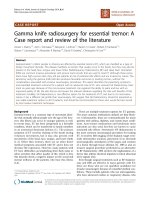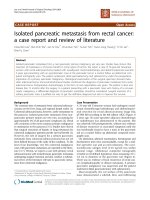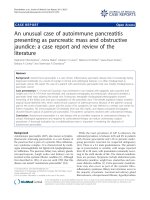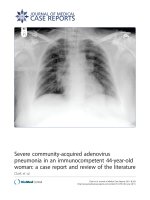Báo cáo y học: "Salmonella enterica ssp. arizonae infection in a 43-year-old Italian man with hypoglobulinemia: a case report and review of the literature" pptx
Bạn đang xem bản rút gọn của tài liệu. Xem và tải ngay bản đầy đủ của tài liệu tại đây (257.86 KB, 4 trang )
CAS E REP O R T Open Access
Salmonella enterica ssp. arizonae infection in a
43-year-old Italian man with hypoglobulinemia:
a case report and review of the literature
Stefano Di Bella
1*
, Alessandro Capone
1
, Eugenio Bordi
2
, Emma Johnson
3
, Maria Musso
1
, Simone Topino
1
,
Pasquale Noto
1
and Nicola Petrosillo
1
Abstract
Introduction: Salmonella enterica ssp. arizonae is an uncommon human pathogen with serious infections reported
in immunocompromised hosts. In Europe, only a few cases have been described. Patients with this infection
usually have a history of contact with reptiles or travel abroad. We present a case report of infection in a patient
with hypoglobulinemia and a literature review.
Case presentation: We describe the case of a 43-year-old Caucasian Italian man with hypoglobulinemia who
presented to our hospital with sepsis and diarrhea. A stool culture yielded S. enterica ssp. arizonae. Our patient was
treated with oral ciprofloxacin and made a full recovery. We also present a review of the cases of S. enterica ssp.
arizonae in fections previously reported in Europe.
Conclusions: The majority of infections from S. enterica ssp. arizonae occur in patients who are
immunocompromised. Data from the literature suggests that it may be difficult to eradicate the bacteria and thus,
prolonged antibiotic courses are often used. It would be advisable for clinicians to investigate for pre-existing
immune dysfunction if S. enterica ssp. arizonae is isolated. In Italy, although there have only been a few cases, the
likely route of transmission remains unclear and requires further surveillance.
Introduction
Salmonella enterica ssp. arizonae is an uncommon
human pathogen with serious human infections reported
in hosts with impaired immune function. S. enterica ssp.
arizonae infections have been well descr ibed in patients
resident within the southwestern part of the US and in
Mexico, whereas in Europe only a few cases have been
reported. Patients with this infection usually have a
history of contact with reptiles or travel abroad.
We pre sent a case report of S. enterica ssp. arizonae
infection in an adult patient with hypoglobulinemia and
literature review of previous cases.
Case presentation
A 43-year-old Caucasian Italian man was admitted to
our hospital presenting with fever, mucoid diarrhea and
abdominal cramps for the past 20 days. Associated
symptoms included malaise and a 5 kg weight loss dur-
ing this time. During the previous week he had taken
paromomycin along with bacitracin and neomycin, with
no clinical improvement.
He had been diagnosed with Hodgkin’ sdisease15
years previously, which was treated with chemotherapy
and autologous b one marrow transplant. Three years
ago he had experienced a relapse, which was treated
with chemo therapy alone. Since then a residual panhy-
poglobulinemia had been recorded in our patient. He
reported extensive travel to many countries around the
world, but not during the last year. He was taking no
medications and had no known drug allergies.
On admission he was unwell with fever (38.5°C),
hypotension (90/60 mmHg) and signs of dehydration.
His lungs were clear and cardiac evaluation was normal.
He had abdominal tenderness but there was no organo-
megaly or masses on palpation. Chest radiograph,
* Correspondence:
1
Second Infectious Diseases Division, National Institute for Infectious
Diseases, ‘Lazzaro Spallanzani’, Via Portuense, 292 00149, Rome, Italy
Full list of author information is available at the end of the article
Di Bella et al. Journal of Medical Case Reports 2011, 5:323
/>JOURNAL OF MEDICAL
CASE REPORTS
© 2011 Di Bella et al; licensee BioMed Central Ltd. This is an Open Access article distributed under the terms of the Creative Commons
Attribution License (htt p://creativecommons.org/licenses/by/2.0), which permits unrestricted use, distribution, and reproduction in
any medium, pro vided the original work is properly cited.
abdomen ultrasound and electrocardiogram results
showed no abnormalities.
Blood cultures and stool cultures for Salmonella spp.,
Shigella spp, Campylobacter spp. and Yersinia spp. were
sent to our laboratory. Fecal examinations revealed pre-
sence of fecal occult blood (+++) and many leukocytes.
Investigation for parasites and immunofluorescence for
Giardia were negative. Biochemical analysis showed a nor-
mal white blood cell count (4.3 × 10
3
cells/mm
3
)but
revealed very low levels of immunoglobulins: IgG 91 mg/
dL (range 800 to 1500 mg/dL), IgA 4 mg/dL (range 90 to
450 mg/dL) and IgM 1 mg/dL (range 60 to 350 mg/dL).
Transaminases, renal function and coagulation studies
were normal. Inflammatory markers, including erythrocyte
sedimentation rate and C reactive protein, were elevated.
Blood culture results were negative and supportive therapy
with intravenous fluids was started.
On the sixth day of admission, Gram-negative bacilli
were isolated from stool cultures and the bioMérieux
VITEK
®
2 system was used to identify the S. enterica ssp.
arizonae. Phenotyping of this Salmonella isolate was also
performed by the API 20E system (bioMèrieux), confirm-
ing the subspecies.
The bacterium was susceptible to all the tested antibio-
tics (Table 1). Therefore antimicrobial therapy with oral
ciprofloxacin (500 mg every 12 hours) was started, after
which there was a rapid improvement in our patient’ s
clinical condition, with complete defervescence and
cessation of the diarrhea.
Due to the severe humoral immunodeficiency in our
patient, ciprofloxacin was continued for a total of 28
days. Our rationale was the evidence in the literature
that suggests possible later relapse if short antibiotic
treatment courses are used [1]. He continued to
improve and fecal cultures taken one week and two
weeks after the discontinuation of antibiotic therapy
were negative.
Discussion
Salmonella spp. are Gram-negative bacilli and members
of the Enterobacteriaceae family. They are documented
to be pathogens that cause a spectrum of diseases in
humans and animals, i ncluding domesticated and wild
mammals, reptiles, birds, and insects. Salmonella spp.
infections are caused by consumption of contaminated
food, person-to-person transmission, waterborne trans-
mission and numerous environmental and animal
exposures.
S. enterica ssp. arizonae is one of the less common sub-
species of Salmonella. Like many non-typhoidal salmo-
nellae, it is mostly found in animal species (commonly
reptiles) and only occasionally infects humans. Snakes
appear to be important carriers of this bacterium, with as
many as 78.8% harboring the organism [2].
S. enterica ssp. arizonae can be difficult to identify due
to their distinguishing biochemical features, which
include the ability to utilize malonate, liquefy gelat in
and the inability to grow in the presence of KCN (potas-
sium cyanide). Isolation of S. enterica ssp. arizonae from
the stools is difficult as some strains ferment lactose
within 48 hours (approximately 15%) and they may be
routi nely d iscarded as non-pathogens. However the pre-
sence of hydrogen sulfide is an important diagnostic
clue during routine screening [3].
This Salmonella isolate did not ferment lactose within
the first 24 hours so it was further investigated as a
Table 1 Tested antibiotics
Antibiotic Minimal inhibitory concentration, μg/mL Sensitivity
Amikacin ≤2S
Amoxicillin/Clavulanate ≤2S
Ampicillin ≤2S
Cefepime ≤1S
Cefotaxime ≤1S
Ceftazidime ≤1S
Ciprofloxacin ≤0.25 S
Ertapenem ≤0.5 S
Gentamicin ≤1S
Imipenem ≤1S
Levofloxacin ≤0.12 S
Meropenem ≤0.25 S
Piperacillin/Tazobactam ≤4S
Tobramycin ≤1S
Trimethoprim/Sulfamethoxazole ≤20 S
S = sensitive; I = intermediate; R = resistant.
Di Bella et al. Journal of Medical Case Reports 2011, 5:323
/>Page 2 of 4
Salmonella species. However, it is prudent, particularly
in patients who are immunosuppressed presenting with
fever and diarrhea, that coliforms of potential signifi-
cance are identified where possible. The use of commer-
cial identification kits or automated systems such as
VITEK 2, may be necessary.
Since it is becoming increasingly common to keep
reptiles as pets, it appears that the incidence of infection
with S. enterica ssp. arizonae is increasing [1]. The
organism is part of the normal reptile intestinal flora
but can cause disease in monotremes, turkeys, chickens,
goats, and humans [4]. S. enterica ssp. arizonae enteritis
or systemic infections have been well described in
patients resident in the southern states of the USA [5],
whereas in Europe it is much rarer, with only a few
cases reported in the literature [ 4,6-17]. Many cases
reported in the US-Mexican border region were related
to the use of rattlesnake products (capsules composed
of a powder of dried, crushed snake) as an altern ative
form of medical treatment [5]. This is a common
practice in Mexican folk remedies. Rattlesnake capsules
are easily obtained in Mexico without a prescription [5].
Most cases of invasive S. enterica ssp. arizonae infec-
tion have been either in younger patients o r those with
underlying diseases including collage n vascular diseases,
malignancy, organ transplantation and HIV infection
[18]. This case highlights, once again, the association
between the immunocompromised host and increased
susceptibility to S. enterica ssp. arizonae.
We performed a review of the literature available
using the PubMed database, searching for cases of
S. enterica ssp. arizonae infections reported in Europe.
We found 16 articles from 1992 to 2010. Features of the
reported cases are presented in Table 2 [4,6-17].
In the cases reported in Europe, S. enterica ssp. arizo-
nae infections are frequently associated with reptile
exposure and underlying diseases, similar to those found
in North-Central America. However, in Italy only three
cases of this infection have been reported but none
described any contact with reptiles.
Table 2 European cases of Salmonella enterica ssp. arizonae infection
Reference (first
author/year)
Country Type of infection
(no. of cases)
Possible exposure Specimens Underlying conditions
Aiken, 2010 [5] UK Unknown (3) Reptiles (two patients), not
reported (one patient)
Not reported Not reported
Schneider, 2009
[6]
France Septic arthritis (1) Snake Synovial fluid Young age
Bertrand, 2008 [7] Belgium Not reported (3) Snakes (three patients) Not reported Young age (two patients),
dialytic treatment (one
patient)
Netherlands Not reported (16) Reptiles (most patients) Not reported Not reported
Germany Not reported (2) Snakes (two patients) Not reported Young age (one patient),
unknown (one patient)
Ireland Not reported (1) Snake Not reported Young age
Starakis, 2007 [8] Greece Endocarditis (1) Vegetables contaminated with
turtles feces
Blood Sickle cell disease, secondary
hemochromatosis
Ozdemir, 2006 [9] Turkey Sepsis (1) Unknown Blood AIDS
Foster, 2005 [10] UK Gastroenteritis (1) Reptiles Stools Young age
Salavert, 2002 [11] Spain Abdominal abscess
(1)
Veterinarian patient Pericardial effusion,
pericardial biopsy
Obesity
Catani, 2002 [12] Italy Pericarditis (1) Travels Pus Chronic renal failure on
dialytic treatment
Carfagna, 1998*
[13]; Galiè, 1997*
[14]
Italy Severe sepsis (1) Travels Blood Idiopathic CD4+
lymphocytopenia
Carfagna, 1998
[13]
Italy Septic shock (1) Travels Brain and lungs,
autoptic specimens
Chronic lymphatic leukemia
on cytostatic treatment
Sanyal, 1997 [15] UK Gastroenteritis (1) Snakes Stools Young age, Netherton’s
syndrome
Buck, 1997 [16] UK Gastroenteritis (1) Reptiles (snake) Stools Young age
Hall, 1992 [17] UK (66 cases
from 1966 to
1990)
Enteritis (55),
symptomless (6),
unknown (3)
Travels 23 patients (35%),
terrapins two patients, snakes 11
patients
Blood (two
patients), stools (66
patients)
49% of infections occurred
in babies and young
children
*Same clinical case.
Di Bella et al. Journal of Medical Case Reports 2011, 5:323
/>Page 3 of 4
This is the fourth case reported in Italy and, indeed,
our patient also had no history of contact with reptiles.
In a study conducted in UK from 1966 to 1990, 12 iso-
lations of S. enterica ssp. arizonae were derived from
human foods and, among these, seven isolates were
from imported Italian pasta [17]. A recent study
detected S. enterica ssp. arizonae from Pecorino Abruzz-
ese, a traditional cheese produced in Central Italy [19].
Therefore, it is possible that our patient contracted the
bacteria from the ingestion of contaminated food.
S. enterica ssp. arizonae has been found to be suscepti-
ble to commonly prescribed antibiotics in several of the
case reports, as was the strain isolated from our patient.
Conclusions
The isolation of S. enterica ssp. arizonae is commonly
associated with a deficit of the immune status, as in the
case of our patient. Indeed, the great majority of infec-
tions from S. enterica ssp. arizonae occur in patients
who present with underlying medical conditions.
Data from the literature suggest that, for patients who
are immunocompromised, it may be more difficult to
eradicate the bacteria and thus prolonged antibiotic
courses (> 14 days) are often advisable. The absence of
recurrence in our patient suggests that 28 days was an
appropriate course length.
In conclusion, although infection from S. enterica ssp.
arizonae is rare, it is most prevalent in patients of a
younger age or those with underlying diseases. Therefore,
it would be advisable for clinician s to investigate for pre-
existing immune dysfunction if S. enterica ssp. arizonae is
isolated. Finally, in Italy, although there have only been a
few cases, the likely route of transmission remains unclear
and requires further surveillance.
Consent
Written informed consent was obtained from the patient
for publication of this case report and any accompany-
ing images. A copy of the written consent is available
for review by the Editor-in-Chief of this journal.
Acknowledgements
This work was supported by a grant from Ricerca Corrente Istituti di
Ricovero e Cura a Carattere Scientifico (IRCCS).
Author details
1
Second Infectious Diseases Division, National Institute for Infectious
Diseases, ‘Lazzaro Spallanzani’, Via Portuense, 292 00149, Rome, Italy.
2
Microbiology Laboratory, National Institute for Infectious Diseases, ‘Lazzaro
Spallanzani’, Via Portuense, 292 00149, Rome, Italy.
3
Clinical Microbiology
Registrar, Sheffield Teaching Hospitals Trust, Sheffield, UK.
Authors’ contributions
SD and MM monitored our patient during hospitalization and analyzed data
from the literature. EB isolated and identified the bacterium. AC, PN and ST
performed the follow-up of our patient after discharge. EJ was the major
contributor in writing the manuscript. NP reviewed the manuscript. All
authors have read and approved the final manuscript.
Competing interests
NP has received industry honoraria for lecturing from Wyeth, GSK, Pfizer,
MSD, Novartis, Sanofi Aventis, Janssen Cilag, Carefusion, Astellas, Gilead. All
other authors report no conflicts.
Received: 28 December 2010 Accepted: 22 July 2011
Published: 22 July 2011
References
1. Bhatt BD, Zuckerman MJ, Foland JA, Polly SM, Marwah RK: Disseminated
Salmonella arizona infection associated with rattlesnake meat ingestion.
Am J Gastroenterol 1989, 84:433-435.
2. Habermalz D, Pietzsch O: Identification of arizona bacteria. A contribution
to the problem of salmonella infections among reptiles and amphibians
in zoological gardens. Zentralbl Bakteriol Orig A 1973, 225:323-42.
3. Winn W, Allen SD, Allen S, Janda W, Koneman EW, Schreckenberger PC,
Procop GW, Woods GL: Koneman’s Color Atlas and Textbook of Diagnostic
Microbiology. 6 edition. Baltimore, MD: Lippincott Williams & Wilkins; 2006.
4. Aiken AM, Lane C, Adak GK: Risk of Salmonella infection with exposure to
reptiles in England, 2004-2007. Euro Surveill 2010, 15:19581.
5. Casner PR, Zuckerman MJ: Salmonella arizonae in patients with AIDS
along the U.S Mexican border. N Engl J Med 1990, 323:198-199.
6. Schneider L, Ehlinger M, Stanchina C, Giacomelli MC, Gicquel P, Karger C,
Clavert JM: Salmonella enterica subsp. arizonae bone and joints sepsis. A
case report and literature review. Orthop Traumatol Surg Res 2009, 95:237-242.
7. Editorial team, Bertrand S, Rimhanen-Finne R, Weill FX, Rabsch W,
Thornton L, Perevoscikovs J, van Pelt W, Heck M: Salmonella infections
associated with reptiles: the current situation in Europe. Euro Surveill
2008, 13:18902.
8. Starakis I, Siagris D, Karatza C, Solomou H, Bassaris H: Endocarditis due to
Salmonella enterica subsp. arizonae in a patient with sickle cell disease: a
case report and review of the literature. Cardiovasc Hematol Disord Drug
Targets 2007, 7:199-204.
9. Ozdemir D, Sahin I, Sencan I: Salmonella arizonae bacteraemia in a
Turkish patient with AIDS but no history of contact with reptiles. Scand J
Infect Dis 2006, 38:237-238.
10. Foster N, Kerr K: The snake in the grass–Salmonella arizonae
gastroenteritis in a reptile handler. Acta Paediatr 2005, 94:1165-1166.
11. Salavert M, Navarro V, Roig P: Purulent pericarditis due to Salmonella
enterica subsp. arizonae. Enferm Infecc Microbiol Clin 2002, 20
:47-49.
12. Catani M, De Milito R, Intrieri F, Fidente D, Venditti M, Manili G, Siani A,
Capitano S: Systemic Salmonella arizona infection: description of a rare
surgical case. Minerva Chir 2004, 59:75-78.
13. Carfagna P, Brandimarte C, Bianco G, Galiè M, Paris A, Venditti M: Systemic
Salmonella arizonae infections in patients with a deficiency of cell-
mediated immunity. A report of 2 cases and a review of the literature.
Recenti Prog Med 1998, 89:632-636.
14. Galiè M, Cassone M, Ausiello C, Serra P: Idiopathic CD4+ T-lymphocyte
deficiency: the clinical evolution of a case. Ann Ital Med Int 1997, 12:233-237.
15. Sanyal D, Douglas T, Roberts R: Salmonella infection acquired from
reptilian pets. Arch Dis Child 1997, 77:345-346.
16. Buck JJ, Nicholls SW: Salmonella arizona enterocolitis acquired by an
infant from a pet snake. J Pediatr Gastroenterol Nutr 1997, 25:248-249.
17. Hall ML, Rowe B: Salmonella arizonae in the United Kingdom from 1966
to 1990. Epidemiol Infect 1992, 108:59-65.
18. Hoag JB, Sessler CN: A comprehensive review of disseminated Salmonella
arizona infection with an illustrative case presentation. South Med J 2005,
98:1123-1129.
19. Chaves-López C, De Angelis M, Martuscelli M, Serio A, Paparella A, Suzzi G:
Characterization of the Enterobacteriaceae isolated from an artisanal
Italian ewe’s cheese (Pecorino Abruzzese). J Appl Microbiol 2006,
101:353-360.
doi:10.1186/1752-1947-5-323
Cite this article as: Di Bella et al.: Salmonella enterica ssp. arizonae
infection in a 43-year-old Italian man with hypoglobulinemia: a case
report and review of the literature. Journal of Medical Case Reports 2011
5:323.
Di Bella et al. Journal of Medical Case Reports 2011, 5:323
/>Page 4 of 4









